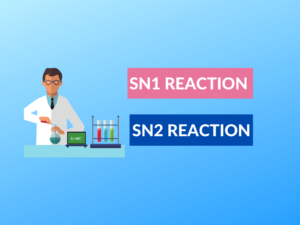Difference Between SN1 and SN2 Reactions
What is SN1 Reaction?
SN1 (Substitution Nucleophilic Unimolecular) reaction is a type of nucleophilic substitution reaction that involves a two-step mechanism. In the first step, the leaving group leaves the molecule, forming a carbocation intermediate. In the second step, the nucleophile attacks the carbocation to form the final product.
Examples of SN1 Reactions:
1. The iodination of tertiary butyl chloride:
CH3
|
CH3-C-Cl + I- → CH3-C-I + Cl-
2. The hydrolysis of tert-butyl bromide:
(CH3)3C-Br + H2O → (CH3)3C-OH + HBr
Uses of SN1 Reactions:
– SN1 reactions are often used in organic synthesis to create new compounds.
– They are commonly employed in the production of pharmaceuticals.
– SN1 reactions are useful in studying reaction rates and mechanisms.
What is SN2 Reaction?
SN2 (Substitution Nucleophilic Bimolecular) reaction is another type of nucleophilic substitution reaction that involves a one-step mechanism. In SN2 reactions, the nucleophile directly attacks the substrate while the leaving group exits in the same step.
Examples of SN2 Reactions:
1. The halogenation of alkyl halides:
CH3-Br + Cl- → CH3-Cl + Br-
2. The deprotection of benzyl-protecting groups:
PhCH2-Bz + OH- → PhCH2-OH + Bz-
Uses of SN2 Reactions:
– SN2 reactions play a crucial role in nucleotide synthesis, particularly in DNA and RNA synthesis.
– They are used in the production of pesticides and herbicides.
– SN2 reactions are widely employed in organic laboratory procedures for various applications.
Differences Between SN1 and SN2 Reactions:
| Difference Area | SN1 Reaction | SN2 Reaction |
|---|---|---|
| Mechanism | Proceeds via a two-step mechanism | Proceeds via a one-step mechanism |
| Carbocation Formation | Formation of carbocation intermediate | No carbocation formation |
| Steric Hindrance | Tolerates steric hindrance | Cannot tolerate significant steric hindrance |
| Nucleophile Strength | Does not depend on nucleophile strength | Depends on nucleophile strength |
| Leaving Group | Can proceed with both good and poor leaving groups | Requires a good leaving group |
| Solvent Effects | Polar protic solvents are favorable | Polar aprotic solvents are favorable |
| Reaction Rate | First-order reaction rate | Second-order reaction rate |
| Solvent Assistance | Carbocation formation can be assisted by the solvent | No solvent assistance in the reaction |
| Concentration Dependencies | Rate depends only on substrate concentration | Rate depends on both substrate and nucleophile concentration |
| Reaction Conditions | Typically requires mild reaction conditions | Requires more reactive conditions |
Conclusion:
In summary, SN1 and SN2 reactions are two different types of nucleophilic substitution reactions with distinct mechanisms and requirements. SN1 reactions involve the formation of a carbocation intermediate and are more tolerant of steric hindrance. On the other hand, SN2 reactions occur in a single step without carbocation formation and are sensitive to steric hindrance. The choice between SN1 and SN2 reaction types depends on the specific reaction requirements and substrate characteristics.
People Also Ask:
Q: What factors influence whether a reaction follows SN1 or SN2 mechanism?
A: Factors such as the nature of the substrate, the strength of the nucleophile, steric hindrance, and solvent polarity influence whether a reaction follows the SN1 or SN2 mechanism.
Q: Can SN1 and SN2 reactions occur simultaneously?
A: No, SN1 and SN2 reactions are mutually exclusive, as their mechanisms and requirements are significantly different.
Q: Are SN1 reactions faster than SN2 reactions?
A: SN1 reactions are generally slower compared to SN2 reactions, as they involve a two-step mechanism involving the formation of a carbocation intermediate.
Q: Can SN1 and SN2 reactions be used for the same type of substrates?
A: While SN1 and SN2 reactions can be used for some similar substrates, the choice of reaction type depends on the specific substrate and reaction conditions.
Q: Are SN1 and SN2 reactions reversible?
A: SN1 and SN2 reactions can be reversible, but the reversibility depends on the specific reaction conditions and the stability of the intermediates involved.


